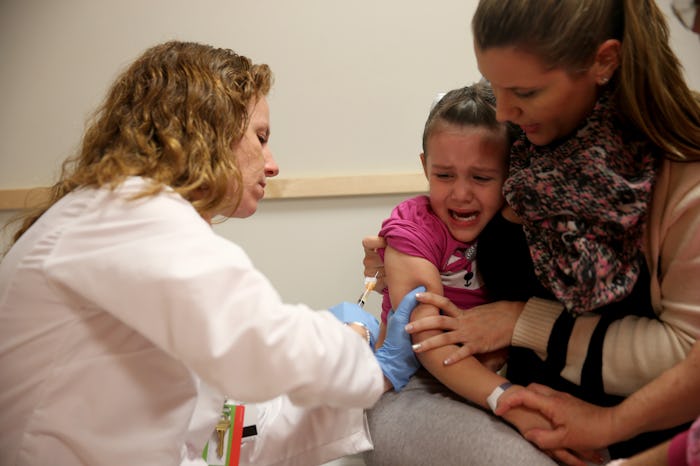The days of dragging children, kicking and screaming, into the doctor's office for booster shots may soon be behind us. Researchers are developing an alternative to the flu vaccine, a microneedle patch. But would a flu patch work for kids? Maybe one day.
The flu patch is applied on the skin and then pressed down to insert the vaccine. Researchers in the study explain how it works, according to CNN:
They are placed on a Band-Aid-like structure, and then that Band-Aid is applied, in this case, to the wrist," she said. "There is an audible snap that you hear when you apply enough pressure to ensure that the microneedles will actually penetrate the skin. ... After few minutes, we remove the patch. By then, those microneedles will be completely dissolved within the skin, along with the vaccine.
Research on the flu patch is in its early stages and the study published in the medical journal The Lancet on Tuesday is only in the first stage of its clinical trial. Results, however, were encouraging.
The clinical trial hosted 100 adult volunteers at the Hope Clinic of the Emory Vaccine Center in Atlanta, each of whom were given a form of the flu vaccine between the months of June and September 2015, according to The Lancet, volunteers were randomly grouped into four categories of different vaccination methods.
The first group was given the flu patch by a health care professional; the second received the traditional flu shot; the third received a patch with a placebo vaccine; and the last group self-administered flu patches. Following vaccination, 96 percent of volunteers who used the patch reported no pain at injection site, whereas 82 percent of those who received a traditional shot reported no pain, according to The Lancet.
About a month later, researchers asked participants which method of injection they preferred — the shot or the patch. Roughly 70 percent of those who received the patch said they preferred it to a traditional vaccine or intranasal application, describing it as "itchy" instead of painful.
All of the participants in this study were adults, so it's unclear how the microneedle patch would affect children. However, the study is moving on to its next phases and applications for children could be in its future. Easier methods of vaccination for children could encourage more parents to get their children vaccinated for flu season. According to the U.S. Centers for Disease Control and Prevention, everyone 6 months old and older should receive a flu shot.
Obvious worries about the patch might not be its efficacy, but rather whether its efficacy could be effected by a child's rough-and-tumble lifestyle. Kids get dirty, they take off Band-Aids and stick them to walls, and they love touching things they aren't supposed to touch. Future trials that could determine whether a patch could keep up with kids could prove interesting.
While the implications of the flu patch for children are unclear, researchers are looking for ways to make vaccinations easier and less painful — something to celebrate, for children and parents alike.
